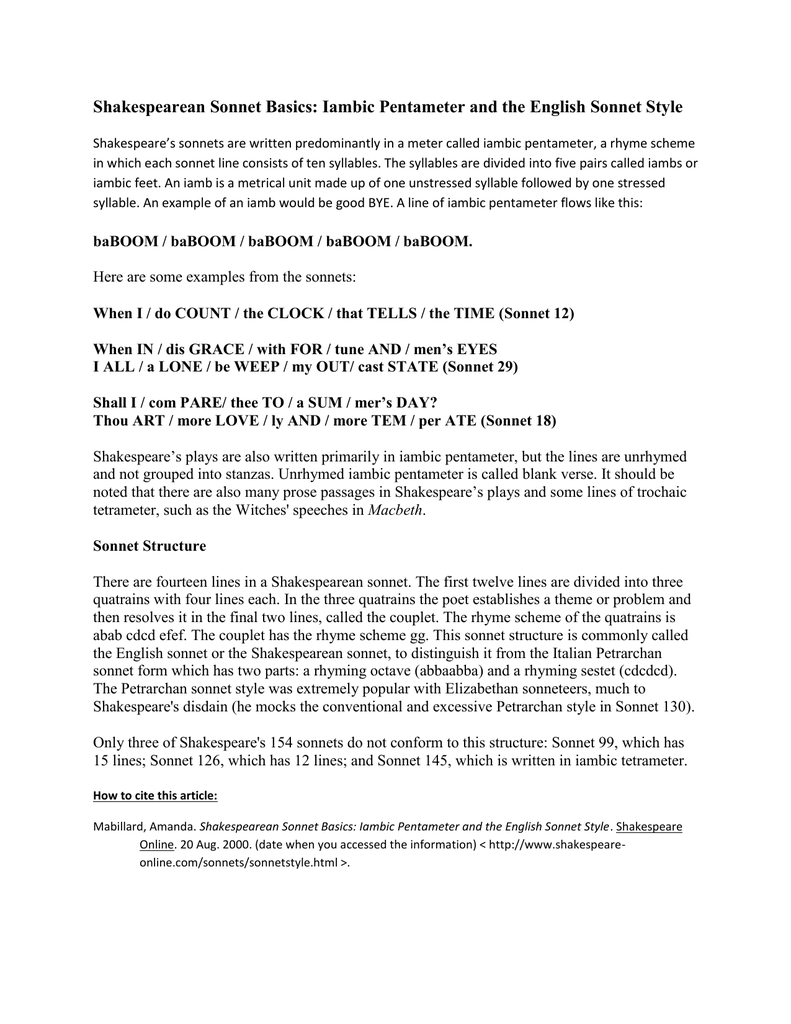
Shakespeare also uses figurative language to bring his message home. This works well with the dominant theme of the poem. The perfect adherence to the classic sonnet form may work to demonstrate the perfection of the beloved being described. While the poetry is elegant and written in high and elevated language, the poem is still easy to read. Every single line is in perfect iambic pentameter and there is no enjambment. Something striking about this poem is how neat and perfectly tied up it is. As a result, Shakespeare uses the sonnet form to highlight his message about his beloved and their magnificent appearance. And historically, sonnets have contained strong themes of love. As a unit of writing, the sonnet has an organic beauty that depends on the balance of symmetrical and asymmetrical form and melody. Each line has 10 syllables, with the first unaccented and the second accented. In addition, the poem is written in iambic pentameter. The first and third lines and second and fourth lines rhyme, and the pattern continues until the last two lines, both of which rhyme.

It is written in 14 lines and contains the rhyme scheme ababcdcdefefgg. Sonnet 18 contains the elements of a classic sonnet. In addition, when the poet describes the sun, he uses the words “gold complexion dimmed.” The poet again downplays the familiar brightness of the warm, comforting sun, referring to its ray as “dimmed.” As a result of describing the season’s climate, the poet wants readers to see that his beloved has looks that will never change and that summer pales greatly in comparison to his beloved.

Shakespeare works to tear down all positive thoughts of summer so that the reader can recognize just how much he lifts up the image of his beloved. He wants to show just how much better his beloved’s beauty is compared to that of summer. “Rough winds do shake the darling buds of May” shows that the poet sees the summer climate as a blow to the spring flowers. He describes summer in a way that contrasts the kind of summer we usually picture. Shakespeare primarily uses imagery of nature throughout the poem to proclaim his feelings about the beauty of his beloved. The easy music of the poem may also work to reinforce the inferiority of summer compared to the beloved. The poet responds to such joy and beauty by ensuring that his beloved will last forever, saved from the oblivion that accompanies death. The latter part of the poem is marked by a more expansive tone exploring deeper feelings. The beloved has become the very standard by which true beauty can and should be judged. His beloved is compared to summer in the first 8 lines as “more lovely and more temperate” than a summer’s day, but at the start of the 9 th line, his beloved becomes summer as the poet states, “but thy eternal summer shall not fade.” With the 9 th line of a sonnet often being the volta or the “turn” of the poem, this may be relevant.

The poet starts the praise of his beloved without ostentation and slowly builds the image of his beloved into that perfect being. Shakespeare uses these devices to also ensure the permanence of his poem, ensuring that it is everlasting and never succumbs to death like his beloved. Several poetic devices enhance the poem’s meaning through the use of form, imagery, and figurative language to express how his beloved possesses an eternal beauty that far surpasses the brightness of that all-too-fleeting summer day. The poem is straightforward in language and intent. The poet begins with an opening question: “Shall I compare thee to a summer’s day?” and spends the rest of the poem answering that question. The stability of love and its power to immortalize someone is the overarching theme of this poem. Shakespeare uses Sonnet 18 to praise his beloved’s beauty and describe all the ways in which their beauty is preferable to a summer day. Poetry Explication: Sonnet 18 (William Shakespeare)


 0 kommentar(er)
0 kommentar(er)
